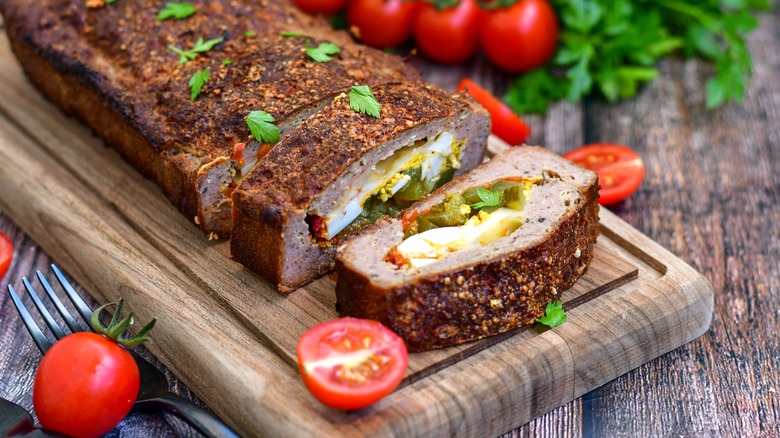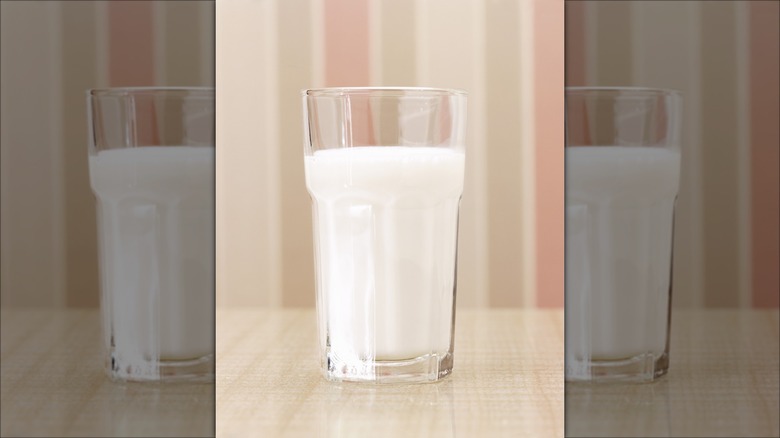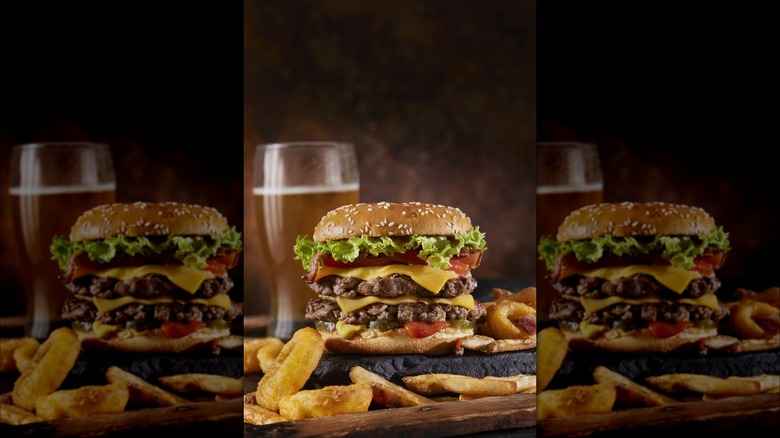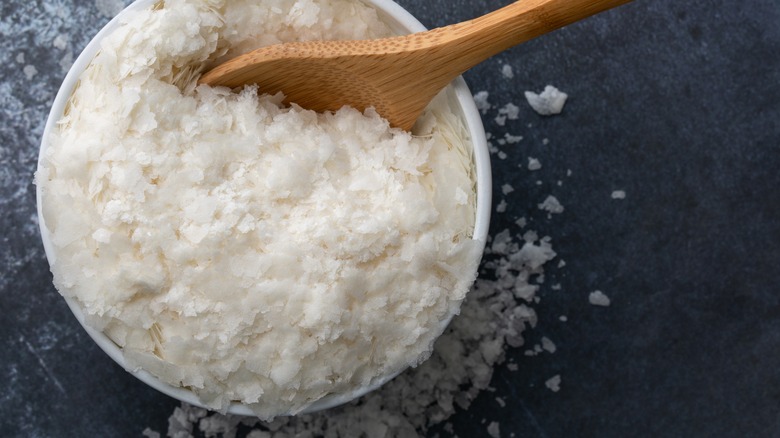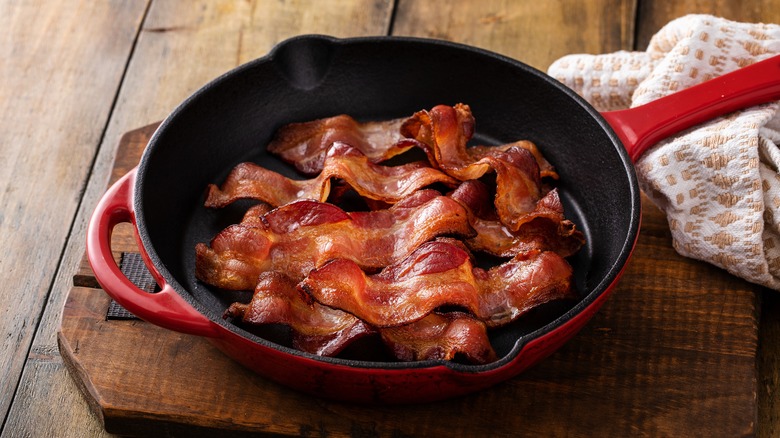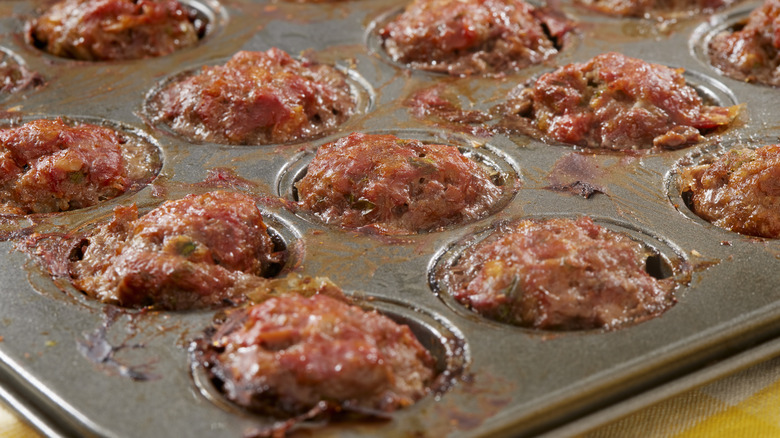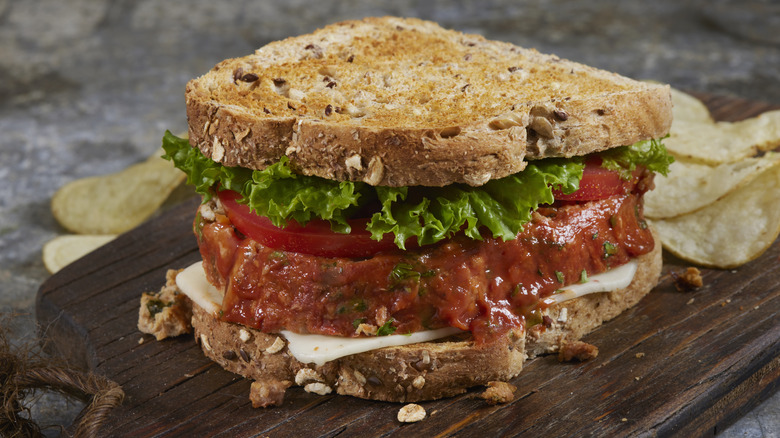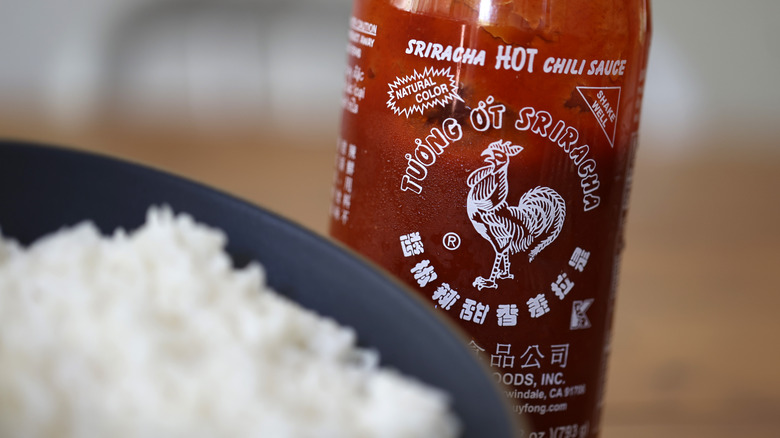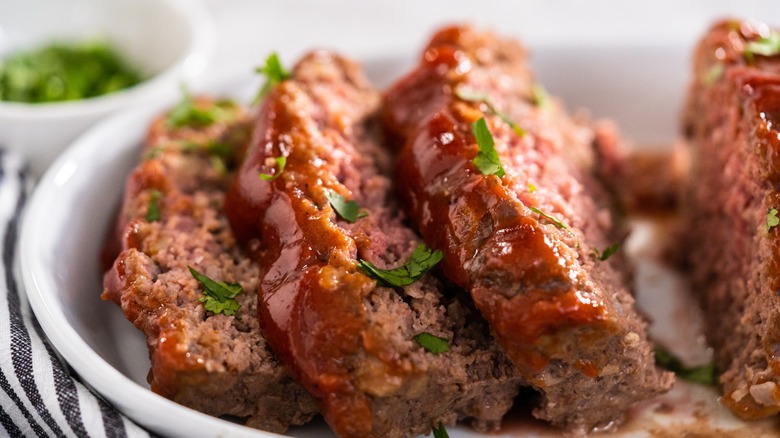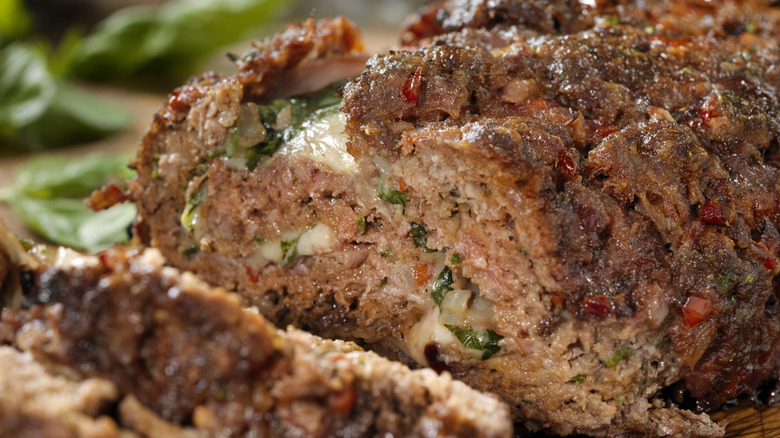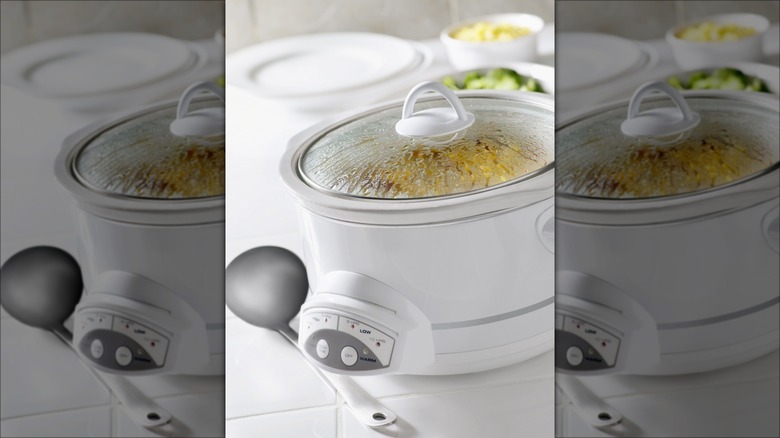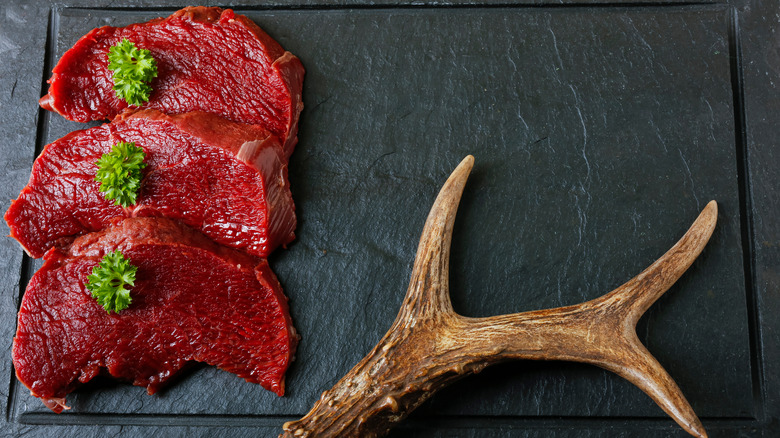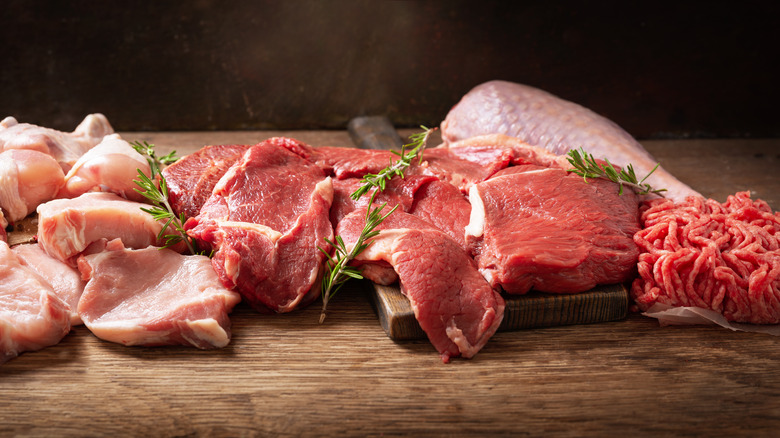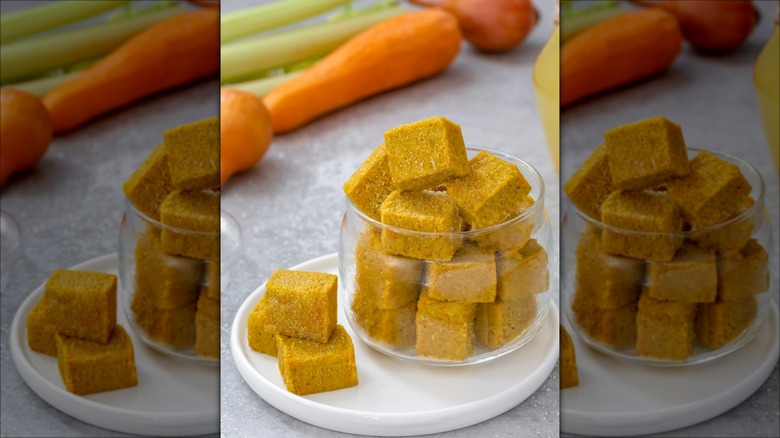Secret Weapon Meatloaf Tricks That'll Make Anyone Jealous
Meatloaf, a common budget dinner staple, seemed to epitomize the practical aspects of home cooking during the "Leave It to Beaver" era. However, the chopped meat recipe's popularity extends farther back in food history than the invention of TV and June Cleaver. As is with many of the classic dishes, like lamb stew, meatloaf's origins go back to at least the medieval days in ancient Rome. The first versions made use of nuts, fruits, and seasonings.
The dish made its way across the Pond when German settlers brought the recipe with them and adapted it to the foodstuffs that the New World had to offer. But it wasn't until the late 1800s that what is now a stereotypical 1950s dinner recipe finally got a mention in the recipes of the day, and interestingly enough, it wasn't something that people turned to at dinnertime. Rather, it was a breakfast food through and through for early lovers of the loaf. Somehow, meatloaf and eggs don't quite have the same ring as steak and eggs, but here we are.
Nowadays, meatloaf recipes are made from different meats and condiments produced in foreign lands and are eventually stuffed with more mozzarella than a stuffed crust pizza and enough onion soup to cure the common cold. What hasn't changed is the combination of starch and protein that's always been the base ingredients on which to build these 13 meatloaf hacks.
Make milk your secret ingredient
Want to make a meatloaf that's moist and tender and yet, has a crisp, tasty crust? Then divert the milk you'd normally put on your cereal into the meatloaf mixture instead. This hack is a trick that home gourmands borrowed from Swedish meatball makers. (Just imagine your meatloaf as an oddly-shaped Swedish meatball, or any meatball, really, and you get the picture.)
Milk acts as one of the binding agents for the breadcrumbs that most cooks put into their meatloaf. The casein proteins in milk function as a coagulant, binding together the ingredients in starches, while at the same time, adding moisture due to the milk's liquid content. If you want to strengthen the effect of the milk in the mix, opt out of the liquid stuff and go straight for the powdered version.
But it's more than milk's binding properties that come into play here. The combo of bread crumbs and milk leaves you with moist meatloaf on the inside and a crispy crust on the outside. In the latter case, you're looking at the Maillard reaction. Three elements make this possible in your milk-infused meatloaf: the bread crumbs, the milk sugar, and the ground meat. When the protein and sugar molecules heat up to at least 284 degrees Fahrenheit and up to 330 degrees Fahrenheit, the browning effect of the Maillard reaction kicks in.
Infuse it with cheese
If you grew up near a local diner, it's likely that you got a taste for this meatloaf hack, even if meatloaf wasn't on the menu. This flavor hack came to you in the form of your basic cheeseburger. And if cheese tastes great on a burger at the local diner, imagine how fabbo it'd taste filling the interior of your fave meatloaf recipe.
There are myriad possibilities for making this cheese and burger combo happen in your meatloaf. The simplest version finds you sprinkling grated cheese on top of the meatloaf a few minutes before you take it out of the oven. This forms a cheesy crust on top of the meatloaf, kind of like the layer of American cheese sitting on top of your cheeseburger. If you'd like a cheesier version, mix the grated cheese with the ground meat mixture before you bake the meatloaf.
If you're feeling really creative, stuff the center of your uncooked meatloaf with cubes of cheddar or mozzarella cheese or both. Cubes of Pepper Jack make for a spicy alternative to those two tamer cheeses. Once the meatloaf is stuffed, bake it as usual.
Use potato flakes for gluten-free meatloaf
Most meatloaf recipes include a couple of binders, like eggs and breadcrumbs, that keep the dish solid in its loaf shape. However, for those who have adopted a gluten-free diet, the breadcrumbs pose a gastrointestinal problem. Fortunately, other binders exist that not only mimic the consistency of breadcrumbs but also add some flavor options that make your meatloaf a standout meal. You'll find these binders at the bottom of your instant mashed potatoes box.
Potatoes contain pectin, which holds the potato together until water is added. Once the potatoes are cooked, the pectin breaks apart, leaving the cells in the tater to also split and expand. This releases those sticky-as-glue starch molecules to soak up the moisture in the meatloaf, creating a thick and tasty binder. It's like having meat and potatoes when you eat meatloaf, without baking a spud or two.
There's another advantage to this binder aside from the obvious hold-your-meatloaf-together component. Many potato flake packets come with herbs and spices and even cheese flavoring. Toss one of those into your meatloaf to infuse the roll with some extra flavor.
Bacon makes everything better
To give your meatloaf some smoky inspiration, look no further than your morning breakfast plate. The bacon that offers a Jerry Maguire level of completion to your eggs can do the same for your meatloaf. Bacon-wrapped meatloaf might just be the budget-conscious cook's way of imitating some of the best cuts of steak. Think filet mignon, and you get the picture.
For this meatloaf recipe, you'll forego the loaf pan. Instead, it's cooked on a baking sheet. Because the sides of the meatloaf aren't encumbered by the sides of the pan, you'll have an easier time wrapping the meatloaf with the bacon.
Prep the meatloaf by slathering a layer of your favorite barbecue sauce on its top and sides. Wrap the uncooked bacon around the meatloaf once the barbecue sauce is loaded up. The bacon shouldn't be wrapped all the way around the loaf, however. It won't cook correctly if you do this. Instead, tuck the ends of the bacon under the bottom of the meatloaf. As the meat cooks, the bacon will shrink, pulling the ends of it out from under the bottom. Eventually, the bacon will hug the sides of the loaf, leaving you with a barbecue-y, smoky dinner.
Make individual meatloafs to freeze
Meatloaf is one of those practical foods that fall into the make-some-now-save-for-later category. In the most basic sense, it's a food that often lives on as leftovers for a couple of days in the fridge. However, when prepped just right, it also fills your freezer with dinners for weeks or even months to come. For this eventuality, it's acceptable to make standard-sized meatloaf. But maybe you should rethink this and go with your mini loaf pans or even your muffin pans. With these, it's possible to create mini-sized loaves that make dinner for one a cinch.
Your mini meatloaf rolls will go into the freezer uncooked and last about six months. Once you're ready to cook them, remove them from the freezer and allow them to thaw in the fridge overnight before putting them in the oven.
This isn't to say that you can't also bake some mini meatloafs ahead of time, which you earmark for the freezer. If you opt to cook them before freezing, pay special attention to how you freeze them. Place them in the freezer on parchment paper to allow them to become frozen solid. Once they are, wrap them up in a freezer bag or plastic container with a lid. Doing this ensures that any sauce or juices don't stick to the bag once the meat is frozen. Your cooked meatloaf lasts in the freezer for about three months before it's time to eat it or toss it.
Use leftover meatloaf for sandwiches, soups, and other recipes
When you're making meatloaf, do yourself a favor and make some extra so that you have plenty of leftovers for tomorrow and the days after. Meatloaf is such a versatile dish that it's so much more than meatloaf the second time around. True enough, the microburner will heat it up, along with those amazing mashed potatoes, that you made last night. That's the easiest way to enjoy meatloaf as a leftover.
But meatloaf leftovers also taste great as the stuffing for a hearty sandwich. Slather some mustard, mayo, and ketchup on a bun or some bread, fill the sammy with veggies, and add a side of chips to make a quick lunch. Meatloaf also infuses chilis and stews with unique flavors based on the types of seasonings and sauces you use to make the meatloaf. Think chili flavored with barbecue sauce, bacon, or even cheese, and you have the right idea. Finally, a little crumbled meatloaf tossed into your favorite mac and cheese recipe makes a delish homemade version of Hamburger Helper that would make Lefty, the Hamburger Helper mascot, proud.
Add some Sriracha or barbecue sauce for a spicy nip
As far as foodie imports go, Sriracha adds a tangy, sweet flavor to food with a slight garlic aftertaste. And let's not forget that spicy punch. It definitely increases your spice tolerance. The flavors that arise from the red jalapeño peppers in the sauce are where that tastebud punch comes from. Although Sriracha has been around since the 1930s when Thanom Chakkapak of Si Racha unveiled it in Thailand, it didn't gain popularity until the 1980s. Naturally, this bit of spicy red goodness tastes great on pretty much everything, taking Asian food from supreme to positively sublime and turning ordinary recipes, like your classic meatloaf recipe, into a culinary wonder to behold.
Sriracha meatloaf still comes with that other red condiment, ketchup, as well as other niceties, like Worcestershire sauce, mustard, or whatever else strikes the home gourmand's fancy. In other words, since meatloaf is pretty much the recipe equivalent of a kitchen sink recipe, the addition of Sriracha is bound to find a welcome spot in your favorite ground meat dinner. Usually, a standard recipe calls for about a fourth of a cup of the spicy red stuff, but this amount, like all tweaks to a tried-and-true favorite, is open to experimentation and interpretation.
Let it sit for a minute
In a world where do, do, do is the mantra that most people live by, it can seem counterintuitive to allow something to just sit without, well, doing anything. But as it turns out, sitting and doing nothing is just what your meatloaf needs to be cooked to perfection.
If it bothers you, as an overachieving home chef, to think that your meatloaf is doing nothing, take comfort. Although not visible to your meatloaf-loving eyeballs, underneath its steaming surface, quite a bit of chemistry is taking place. When the meat gets hot, the muscle fibers in it change, becoming narrower, and the juices in the meat move around a bit. Taking the meatloaf out of the oven allows the muscle fibers to finish their expanding and contracting activities.
Further, the heat inside the meatloaf remains, causing the meat to continue cooking even when it's pulled from the oven. Allowing it to sit on the counter for 10 minutes before slicing it up completes the cooking process. The wait is worth it, however, because the sitting-and-doing-nothing process encourages the juices and moisture to distribute more evenly throughout the meatloaf.
Add vegetables for flavor and nutrition
The Center for Disease Control (CDC) reports that only one in 10 people eat the recommended amounts of fruits and vegetables each day. Some will try to sneak some fruits into a smoothie or grind up veggies to put in a sauce. For meatloaf lovers, getting enough vegetables in the diet may be as simple as chopping some up and mixing them into their meatloaf dinners. And, the addition of vegetables can be as simple as slicing a few carrots, celery stalks, and onions into the mix. Green peppers and zucchini or even potato bits also have their place in this concoction.
If you whip a veggie meatloaf up for dinner, keep a couple of pointers in mind. Some vegetables, like carrots or potatoes, won't cook enough if you put them into the meatloaf mixture raw. To get around this, saute or boil the vegetables ahead of time. Allow them to cool a bit before tossing them into the ground meat mixture and bake as usual.
Cook in the Crockpot
The slow cooker is a miracle appliance for the busy home chef. Its slow-cooking function takes the concept of dinner in 30 minutes or less and turns it on its head by extending cooking time to hours. Why is this a bonus? Well, because rushing home through 5:00 p.m. traffic is already stressful enough without needing to have dinner on the table 30 minutes or so after arriving. And if you're making meatloaf, forget it. It takes more than 30 minutes just to make it.
But there's a simple solution. Putting meatloaf in the Crockpot in the morning before work and allowing it to cook all day means putting it on the table almost immediately after you get home. Making it is simple, too. Treat the bottom and the sides of the slow cooker with cooking spray. Once you've finished this step, fill the bottom with the meat mixture, then top it with ketchup or barbecue sauce. Cook it on low for five to seven hours. Most slow cookers can be left on low temperatures for the day while you're at work or even overnight while you sleep, making it a viable option for busy working gourmands.
Game meats shake up the game
It's hard to live in the world and not know that commercially bred cattle and pigs get a big dose of hormones, antibiotics, and Frankencorn to eat. For many consumers, the alternative to these meats means either a life of veganism or vegetarianism. Or does it? For those who love the taste of venison, buffalo, rabbit, and other wild meats, the wilderness is a culinary playground, just waiting to be explored via common recipes, like meatloaf.
Creating meatloaf from the wild also appeals to the hunting foodies in the crowd who prefer to know where their food comes from. These meats tend to be better for you, too. Wild game animals, like deer, tend to be leaner, coming in at 3 grams of fat to the cow's 6 grams. Further, many hunters claim that hunting the animals they eat spares them from the yuckiness of the meat packing house. They live free until they are hunted.
And while meatloaf made from wild game comes with a lot of upsides, it's also important for home gourmands to consider the downsides if they want great-tasting meatloaf. Wild game is often leaner than commercial meats, which means that the meatloaf will dry out faster than other kinds. Hacks like adding milk or cheese to the mix may mitigate this issue and add more flavor, too.
A mix of meats tastes better
Often, when people prepare meatloaf, the go-to meat is ground beef. While there is nothing wrong with this, it's possible to shake this concoction up in the most basic, yet delish way. Mix meats. If you do, you'll never have boring meatloaf again.
A common combo is a beef and pork mixture, which gives the dish a bit of a Mediterranean flare. However, with the advent of ground turkey and chicken or even sausage, the culinary possibilities increase, particularly if you take a hint from meatball recipes. After all, many meatloaf recipes would also make tasty meatball recipes (and vice versa). And because meatloaf originated as a dish that allowed home cooks to use up whatever leftover meats they had, the sky's the limit here and experimentation is definitely welcome.
Finally, it's worth mentioning that many plant-based meats, like the Impossible burger, would make an excellent addition to the repertoire, and while you wouldn't necessarily mix that meatloaf with beef or pork, infusing it with lentils may just take the concept of mixing it up to the next level for the ardent plant-based foodie.
Add onion soup for the win
When it comes to flavoring meatloaf, you have the usual suspects: Garlic salt or powder, ketchup, Worcestershire sauce, and maybe mustard. But if you haven't tried onion soup mix meatloaf you're short-changing your meal in the flavor department.
Here's why: Most meatloaf recipes call for chopped onions, which help to add a savory flavor to this famous concoction. Onion soup mix adds the savory flavor of onion to your meatloaf but to the 10th power because the onion flavor in the soup is so concentrated.
However, most soup mixes are filled with more than just onions. There are other seasonings and herbs in those mixes, too, which allow you to flavor your soup on a budget. In other words, it's not necessary to add salt, pepper, and other spices to your meatloaf because the soup already has them in it. To make the most of this hack, just mix the onion soup pack with your breadcrumbs and make the recipe as usual.
